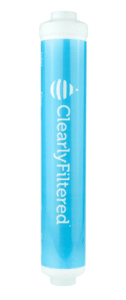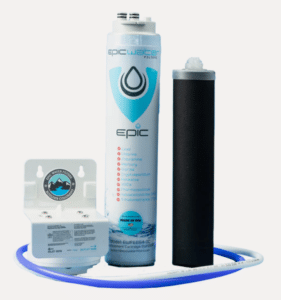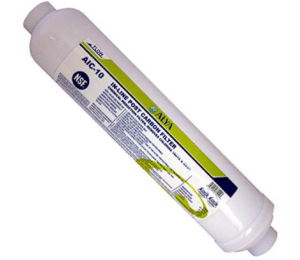The name “inline filters” comes from the fact they are installed directly to the water line. Inline water filters are incredibly compact cylindrical cartridges attached along the water line leading to the faucet, or any home appliances requiring clean water, like refrigerators or coffee makers. They’re are effortless to install, take up little space, and are very affordable.
The best inline water filter of 2023 is the Clearly filtered universal inline fridge filter which offers 365 gallons filter life, 0.75GPM flow rate, and removes more than 232+ contaminants including heavy metals, pollutants and chemicals.
The clearly filtered universal inline filter also ranks top in our article on best refrigerator water filters, which is technically the same thing as inline water filters.
List of Inline Water Filters
- Clearly Filtered Universal Inline Filter
- Epic Smart Shield Universal Inline Filter
- LASCO 37-1821 Inline Water Filter
- Woder WD-10K-JG Inline Water Filter
Clearly Filtered Universal Inline Filter

- Contaminants: 232+ contaminants, including heavy metals, pollutants, and chemicals.
- Filter Life: 365 gallons
- Flow Rate: 0.75 GPM
- Three-stage filtration process
- 30-day money-back guarantee
- Comes with a limited lifetime warranty
- One of the most expensive inline filters on the market
The Clearly Filtered Universal Inline Filter offers three-stage filtration process to reduce over 232 contaminants, the highest number for an inline water filter.
The first stage of filtration is the porous activated carbon media that absorbs chlorine, chloramine, herbicides, and pesticides, as well as bad tastes and odors. The second stage is the specialized heavy metal media that reduces micro-plastics, pharmaceuticals, and heavy metals. The third and final stage is a fluoride media that reduces fluoride and arsenic.
The Clearly Filtered Universal Inline Filter also comes with a few quality-of-life perks, such as free shipping throughout the US and a 30-day money-back guarantee.
Epic Smart Shield Universal Inline Filter

- Contaminants: 116
- Filter Life: 651 gallons
- Flow Rate: 0.50 GPM
- Powerful two-stage filtration system
- Reasonably priced
- Removes 99% of most common water contaminants
- Limited filter life
While most inline filters only use a single-stage filtration process (except for the three-stage Clearly Filtered Inline Filter), the Epic Smart Shield Universal Inline Filter has a two-stage filtration process that passes the water through a hollow fiber membrane and an activated carbon block filter.
The carbon block filter eliminates 96% of chlorine, 99% of copper and uranium, and 98% of PFOAs, mercury, and 94% lead, while the hollow fiber membrane removes micro-organisms like cysts, viruses, and bacteria.
The Epic Smart Shield inline filter has a 651-gallons filter life, which typically lasts 6 – 12 months.
LASCO 37-1821 Inline Water Filter

- Contaminants: Chlorine, sediment, THMs, unpleasant tastes and smells
- Filter Life: 2,500 gallons
- Flow Rate: 0.50 GPM
- 30-day money-back guarantee
- Very affordable
- Decent filter life
- Limited flow rate
The LASCO 37-1821 is a bargain, selling for just $34.82. The price becomes even more attractive when you consider the 2,500 gallons which lasts for about 1-year of use before replacement.
LASCO 37-1821 can be mounted horizontally and vertically, easily fitting on any 1/4-inch line. Additionally, there’s a 30-day return policy if you have issues with installing this unit on your water line or fitting it behind the refrigerator.
One of the notable drawbacks we found with this filter is the flow rate. Inline filters typically have a flow rate of 0.50 GPM – 0.75 GPM, except the Woder WD-10K-JG, which has a flow rate of 3 GPM. LASCO’s 0.50 GPM is at the lower end, which isn’t a big deal to be fair, its just something to keep in mind.
Woder WD-10K-JG Inline Water Filter

- Contaminants: Lead, heavy metals, chlorine, mercury, and ten more.
- Filter Life: 10,000 gallons
- Flow Rate: 3 GPM
- Outstanding flow rate for an inline filter
- Excellent filter life
- 1-year warranty
- The 12″ X 2.52″ X 2.52″ dimension makes this filter cumbersome to place behind a fridge
The Woder WD-10k-JG offers 3 GPM flow rate, which is the highest flow rate for an inline water filter. It comes with 10,000 gallons filter life, which lasts 1 – 3 years before needing replacement. As always, the exact lifetime of the filter will be shortened or extended depending on the amount of water used regularly.
Another strength of this unit is that it can be attached to both 1/4 and 1/8-inch lines, giving it a bit more versatility when it comes to the types of appliances and sinks for which it’s suitable.
Finally, something to keep in mind; The Woder WD-10k-JG measures 12 inches long and 2.5 inches wide, making it a bit larger than the other inline filters, as most are around 10 inches in length and 2 inches in width.
How Does an Inline Water Filter Work?
An inline water filter is a cylinder or a cartridge with filter media inside. The filter has an input point on one end and an output point on the other. Once both sides are connected to the water line in your house, all you need to do is turn on the water.
The water is propelled through the filter media inside the cartridge, where contaminants are neutralized or removed.
Unlike other filters, these filter cartridges don’t need a separate appliance like an RO system to purify the water that passes through them. Once the filter’s life has expired, all you need to do to replace it is throw away the current cartridge and add a new one.
Advantages of Inline Water Filters
Inline filters are incredibly small, so they can be installed anywhere without taking up any space. Their small size is thanks to the fact the filter cartridge is the filter itself — you don’t need to attach the cartridge to a large filtration unit, which saves you space.
On the one hand, these filters don’t have replaceable cartridges and must be thrown away once they expire. But on the other hand, they cost about as much as a standard reverse osmosis system cartridge anyway, so you’re not losing money by replacing the units.
The installation itself may be tricky if you’re not good with tools, but the process itself is not too complicated.
Connect one end of the water line to the input hole on the inline filter, and connect the other part to the output hole. You should be able to attach everything with a little trial and error in about 10 minutes.
Inline filters are also pretty durable. Most filters can only filter a few hundred gallons of water, equal to 2 or 3 months of use, but some inline filters have a life of a year or more.
Disadvantages of Inline Water Filters
Due to their size, inline water filters are mostly single-stage filtration units, which makes them capable of reducing the contaminants in your water to a certain point. However, most aren’t able to handle highly polluted water.
Inline filters are best used with city water that’s already been filtered but still might contain some contaminants. Even the units filtering multiple pollutants will get clogged and won’t be able to remove those same contaminants if the contaminant concentration is too high.
Determining water pollution is another problem. Inline filters don’t have filter life indicator lights or strips like other filtration units, so the only way to determine whether a filter needs to be replaced is to keep an estimate of the amount of water you’ve used.
Alternatively, you may send a water sample to a testing lab or get a home testing kit if you think your water tastes and smells funny. This is the only way to find out if an inline filter can handle the pollutants or if it got blocked up and isn’t working correctly.
The same applies to the filter life. Even if the water is relatively clean and the filter is working as intended, you can’t see when the filter needs to be replaced other than to test the water or manually keep track of your water usage.
Frequently Asked Questions
Let’s answer some of the most common questions regarding inline filters.
The cheapest inline water filter is the Watts Premier Filter which costs $16.49.
Inline filters typically costs between $30 to $60, with the exact price varying depending on their contaminant removal capacity, filter life, and several other factors.
All you need to do to install an inline water filter is to screw it onto a water line in your home. Then, turn off the water leading to the spot where you’ll be attaching the filter, remove the hose from the sink or the appliance, screw the hose on the filter, and screw the filter into the appliance or sink.
Once everything is in place, turn the water on to ensure there are no leaks, and you’re good to go.